Here are answers to the most common technical support questions about Signals.
What power adapter may I use to charge Signals?
We recommend that you always use the power adapter that came with your Signals. It reads “Use only with Signals” on its back.
Signals requires a 12-volt power adapter. Make sure you do not use another type of adapter as other voltages can cause damage or provide insufficient power. (Voltage information can be found on the back of each power adapter.)
If you use a power adapter without enough voltage (such as a standard 5-volt USB adapter), Signals will not fully charge–or charge at all.
If you need a replacement charger, you may purchase a Signals Replacement AC Adapter here.
How do I set up my Signals?
![]()
Notice: The ThermoWorks BBQ app has been replaced by the new, completely redesigned ThermoWorks app. (The icon has a yellow background.)
Controlling your ThermoWorks connected thermometers is an elevated experience with the all-new ThermoWorks app and new ThermoWorks Cloud. The ThermoWorks app boasts powerful new features, a more intuitive interface, and more robust connectivity. Plus, now you can dive into your temperature data from any browser, explore and annotate graphs, and share everything with your team anytime, anywhere on the new ThermoWorks Cloud.
Learn more about the ThermoWorks app here.
Learn more about ThermoWorks Cloud here.
Download the new, free ThermoWorks app from either the iTunes App Store or the Google Play Store. Open the app on your smart device to begin.
Find instructions for setting up and using your Signals in the ThermoWorks app Help File, found here.
Instructions for using ThermoWorks Cloud are found here.
How do I update my Signals’ firmware?
Here’s what you need to know to successfully update your Signals’ firmware.
1. Signals needs to be plugged into power to complete the firmware update. Once your Signals is plugged into power, the firmware update will complete when you next open the ThermoWorks app. Please make sure you use a 12 volt power adapter (preferably the adapter that came with Signals).
2. Signals firmware updates via Bluetooth, so keep your phone or tablet within Bluetooth range of Signals during the update. If your phone or tablet disconnects from Signals, the firmware update will not finish. We recommend leaving your tablet or phone close to Signals until the firmware update has concluded. (The update takes roughly one minute.)
3. Make sure the ThermoWorks app is authorized to use your phone or tablet’s location services, data and file storage. (Found in your phone or tablet’s app manager.) Close and reopen the app and the firmware update will continue.
iPhone/iPad users: iOS13 + includes a new permission requirement for all apps. Go to General Settings> ThermoWorks and verify that Location is set to either While Using or Always.
Android: On most Androids, Location is found under Android Settings > Biometrics and Security.
4. Make sure your phone or tablet’s screen stays active during the firmware update, or the update may fail if your phone or tablet goes to sleep. You can keep your phone or tablet active by occasionally touching the screen.
Note: If your Signals is plugged in using the correct power adapter and your phone or tablet is connected to Signals via Bluetooth and the firmware still does not update, your Signals may need to be reset.
- Close the ThermoWorks app and unplug Signals from the power source.
- Reset Signals by pressing and holding the power button for about 20 seconds. When you let go of the button, your Signals’s display will read INPT PWR.
- Plug Signals it back into power and restart the ThermoWorks app.
- Next, go to the Devices page in the app. After a few minutes, you will see a pop-up window that reads, “A Firmware Update is available for one or more devices.”
- Click Continue. The firmware process should continue successfully.
If the above solutions do not work, please contact our Tech Support team. They are happy to help.
My Signals doesn’t work after I ran the firmware update. The screen has three dashes in each quadrant.
The dashes on the screen indicate that firmware update did not complete or the update process was interrupted. Here’s what to do:
- Close the ThermoWorks app and remove the power adapter power from your Signals.
- Once your Signals reads INPT PWR, plug it back into power and restart the ThermoWorks app.
- Go to the Devices page, followed by your Signals page. You will receive a message that firmware is available. Choose to accept it and continue.
- The firmware update process will begin again.
If you feel that the firmware update is stuck in a loop…
- Toggle your phone’s Wi-Fi connection off and back on again.
- Follow the process above to continue the firmware update.
How can I tell if my Signals battery needs to be recharged? How long is the battery life?
![]()
Important: The battery icon on the Signals hardware is a status indicator only. It flashes when Signals is charging and is solid when it is not charging. Signals battery charge level information is available in the ThermoWorks app.
![]()
The battery icon indicates one of the following statuses: 1. The battery is charging 2. The battery has an adequate charge level 3. the battery needs to be charged. You will receive a push notification alert when the battery’s charge is getting low.
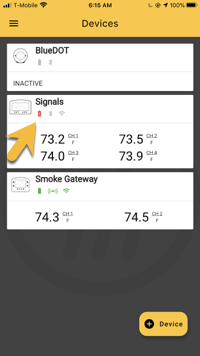
If the battery level is low, the icon will be red with an exclamation mark in it. You will see the alert icon on both the Devices listing and on your Signals page.
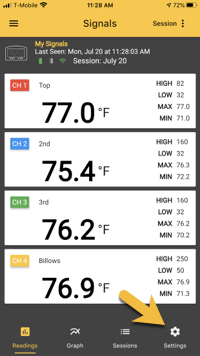
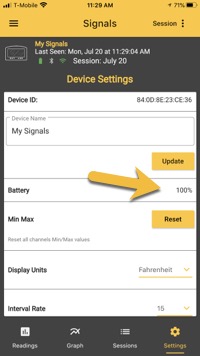
To see more information about the battery charge level, go to your Signals’ Settings.
Battery Life
It takes approximately 10-12 hours for Signals to be fully charged after the battery is completely discharged. You may use Signals while it is plugged in and charging. Once Signals is fully charged, the battery’s charge will last approximately 13-16 hours, depending upon the interval update rate you choose. (The more often Signals sends data to the cloud, the more battery life is used.) You have the option of setting the interval update rate to 15, 30, or 60 seconds apart.
Signals uses extra power when its alarms are sounding. Placing Signals directly on a hot surface can also decrease battery life. (Signals thermometer hardware should not directly exposed to temperatures above 122°F or the plastic housing may melt.)
Important: Signals will not fully charge (or charge at all) with a standard 5-volt USB adapter. Please ensure you are using the 12-volt adapter that accompanied your Signals. It reads “Use only with Signals” on its back.
A Recommendation
If you are doing an overnight cook with frequent interval updates, you may want to consider either keeping Signals plugged in or to use a well-charged 12 volt power bank as a backup. This is what our Marketing team does when they are doing long smokes and Signals isn’t close to a power source.
How do I set up Signals alarms?
Signals includes both High and Low alarms. Both alarms sound on the hardware and on the phone or tablet. You may set the alarms on both the hardware or in the ThermoWorks app. Additional instructions can be found in the ThermoWorks app and in the online help file, located here.
Why does Signals keep alarming? I can’t get it to stop going off.
It sounds like at least one Low Alarm is set too high. The High Alarm sounds when the temperature of the food or environment you’re measuring rises to the high alarm set-point. The Low Alarm sounds when the temperature of the food or environment you’re measuring falls to the low alarm set-point. This feature is especially helpful when you want to make sure that the temperature of the food you’re chilling doesn’t fall too far.
Here’s another example of how the Low Alarm feature can be used:
If you want to make sure that your smoker or oven temperature stays within a temperature zone (say, between 325° and 350°), set the High Alarm to 350°, put the probe within the pre-heated environment (the temperature must already be between 325° and 350°) and set the Low Alarm to 325°. If the temperature of your smoker or oven falls below 325°, the Low Alarm will sound.
If you’d prefer, you can set the Low Alarm while the probe is still at room temperature. If you set it this way, remember to disable the alarm until the food or environment measures above the low set-point. Otherwise, the alarm will immediately start to sound.
How do I reset Signals?
If you find it is necessary to reset your Signals, press and hold down the power button on the back of the thermometer for approximately 20 seconds.
How far away can I take my phone from Signals to get a reading?
Signals will communicate with your phone or tablet via Bluetooth up to 95 feet line-of-sight unless other factors are involved.
- Devices that use 2.4GHz radio frequencies (microwave ovens, cordless phones, remote controls, etc.) may create interference.
- The Bluetooth signal may be interrupted by walls and building materials, such as tinting on windows.
Signals will communicate with your phone or tablet via Wi-Fi anywhere in the world as long as Signals has access to a strong Wi-Fi connection and your phone or tablet has an Internet connection to receive the data (Wi-Fi or cellular)
My Signals is having connectivity issues. What can I try?
Read more about Transmission Distance Specifications here.
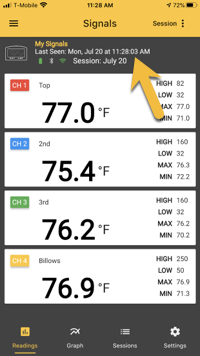
View the Last Seen message at the top of the probe list to determine how and when Signals last communicated with the ThermoWorks app. In this example, Signals is connected via Wi-Fi. The grey Bluetooth icon indicates that it is not connected to Bluetooth.
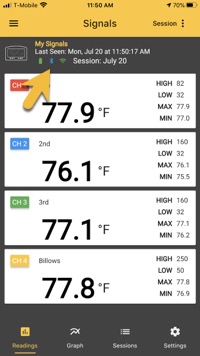
In this example, Signals is connected to both Bluetooth and Wi-Fi.

Access your Signals’ Settings to view connection details.
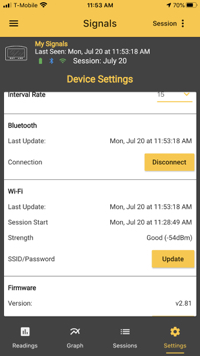
You will see when your Signals last communicated with the ThermoWorks app, if it is connected via Bluetooth and/or Wi-Fi, and the strength of the connection between the local Wi-Fi network and Signals.
You can also disconnect or connect your Signals to Bluetooth and/or Wi-Fi here.
Shouldn’t I be able to monitor Signals when I am away from home? When I leave home, I can’t track my Signals in the ThermoWorks app, but when I return, the data returns.
It sounds like your Signals is using a Bluetooth connection rather than a Wi-Fi connection. This would explain why you didn’t receive data when you were away from home, but started receiving it once you returned.
If Signals is connected to your local Wi-Fi network, temperature data is transmitted to the cloud through Wi-Fi. Your phone (through the ThermoWorks app) connects to ThermoWorks Cloud and pulls down the data, no matter where you take it (as long as your phone is connected to the Internet). However, if Signals is set up to use a Bluetooth connection, the transmission of data to the cloud is dependent upon your phone being nearby.
If you set up Signals with a Wi-Fi connection and the connection isn’t strong enough or is lost, Signals will automatically try to use Bluetooth as a backup until the Wi-Fi connection is reestablished. It may be that the Wi-Fi connection was lost when you were away from home and because your phone wasn’t there, the Bluetooth backup connection couldn’t be made until you returned.
If you need assistance, our Tech Support team is always happy to help. They are available at techsupport@thermoworks.com or 1-800-393-6434.
Bluetooth Troubleshooting Steps
1. Make sure you have location services turned on.
2. Turn Signals and your phone/tablet off and back on again.
3. Switch off your phone/tablet’s Bluetooth, wait for 10 seconds, and switch it on again.
4. Are both devices fully charged? Bluetooth is notorious for affecting battery life and full batteries increase the odds of success.
5. Turn off other Bluetooth devices from the area or disable their Bluetooth functionality.
6. Check if there is another phone in the area that is creating interference. Try temporarily disabling the phone’s Bluetooth signal (in the phone’s settings), taking the phone out of BlueDOT’s range, or turning the phone off while you use BlueDOT.
7. Try removing other Bluetooth connections from your phone/tablet, such as speakers.
8. Are your devices compatible? Make sure you are running the most recent version of your phone/tablet’s operating system.
9. Look at the obstacles that create interference. (Direct line-of-sight is the biggest factor in Bluetooth device performance.) Apple rates the following obstacles according to their level of interference:
- Low interference potential: wood, glass, and many synthetic materials
- Medium interference potential: water, bricks, marble
- High interference potential: plaster, concrete, bulletproof glass
- Very high interference potential: metal
10. Remove potential sources of interference. Interference can come from a variety of devices, some of which don’t transmit anything. Common sources of interference include a high concentration of Wi-Fi signals, USB 3.0 ports, laptops, microwaves, wireless video cameras, cordless phones, microwave ovens, fluorescent lights, power cables, Direct Satellite Service (DSS), baby monitors, electrical equipment emitting strong RFs (power lines, power stations, and electrical railroad tracks), and other devices that use 2.4 GHz or Bluetooth technology.
Wi-Fi Troubleshooting Steps
Make sure that your Signals has been set up with a Wi-Fi connection.
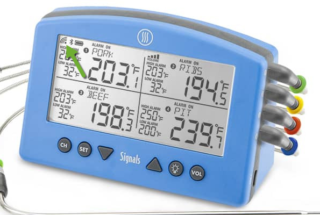
If it is connected to Wi-Fi, you will see a Wi-Fi connection indicator up in the top-left corner of the screen, next to the battery indicator icon. If it has not been set up with Wi-Fi yet, your Signals may be relying on its Bluetooth connection, which has a limited range. Instructions for setting up Signals with a Wi-Fi connection can be found here.
It may be that your Wi-Fi network’s 2.4GHz connection isn’t strong enough in that location to remain connected to Signals. You can check the connection strength in the ThermoWorks app.

Access your Signals’ Settings to view connection details.

You will then be able to view your Signals’ Wi-Fi connection strength.
1. Make sure you are entering network’s login and password correctly. Do not copy and paste the information into the login form as extra spaces may occur at the beginning or end if you do.
2. Make sure you have downloaded and installed the latest version of the ThermoWorks app.
3. Make sure that you have a Wi-Fi or Internet connection on your phone or tablet.
4. Make sure that location services are enabled on your phone or tablet and that the ThermoWorks app is authorized to use location services. (You will find location services in your phone or tablet’s settings.)
5. Make sure you are connecting to a 2.4 GHz (not 5 GHz) network. Because a 2.4 GHz network has a longer range than a 5 GHz network does, a 2.4 GHz frequency network is not as negatively affected by the number of walls, floors, and other objects between the router and the device as a 5 GHz network would be. This makes a 2.4 GHz network the best option whenever a device (such as Signals, which will most often be used outside) cannot be placed close to a Wi-Fi router.
6. Try connecting your phone to your 2.4 GHz network prior to setting up Signals’ connection in the ThermoWorks app.
7. Try taking your Signals outside before setting up its Wi-Fi connection where the 5 GHz network will be weaker and the 2.4 GHz network will be stronger.
Another solution is to give the networks different names so your phone or tablet won’t mix the them up. (Example: mynetwork24 and mynetwork5)
8. Make sure you are not using a VPN (Virtual Private Network).
9. Try restarting both your Signals and phone or tablet.
10. Try disconnecting and reconnecting your phone or tablet to your network. Afterwards, begin the Signals set up process again.
11. Try disabling your phone’s cellular data during the setup process. You can turn it back on once Signals has been set up.
12. A Wi-Fi connection strength test you can easily try is to take your phone next to Signals and disconnect it from its cellular data signal. Then, see if your phone can connect to your local Wi-Fi 2.4GHz network correctly. If your phone has difficulties connecting (or staying connected), you will know that your local Wi-Fi network’s 2.4GHZ signal isn’t strong in that area. Try moving Signals to a different spot. You may also consider using a Wi-Fi booster to increase your network’s Wi-Fi range.
13. Some people have issues connecting to a mesh network when there are multiple router devices in a mesh topology. To get your Signals connected, try unplugging all the routers except one. With only one router to communicate with, Signals should be able to connect to the 2.4 GHz portion of your network. Also with only one router online, the “walk far away” method is more effective because you don’t have to leave the 5 GHz range of multiple devices. Once the Signals is connected, you can turn your other routers back on.
14. Try connecting Signals to another network (such as a friend’s or at work) to determine if the issue is Signals or possibly, your network’s. If you determine that Signals cannot connect to any network, please let our Tech Support team know. Your Signals has a 2-year warranty and we are happy to help.
15. Check your router’s manufacturer’s website to see if there is a firmware update for your router. If there is, install the firmware update, reconnect your phone or tablet to your network, and then, begin the Signals setup process again.
16. If you are using an add block app (such as Adguard), try disabling the app during the Wi-Fi set up process. Once the connection is established, you can re-enable the app.
Please remember that it can take up to a minute for the probe’s temperature readings to update and appear in the ThermoWorks app after the Wi-Fi connection is established.
I’ve noticed that the range of my Signals isn’t very long. I have to keep my phone close to Signals for it to work.
If you have previously set up your Signals with a Wi-Fi connection, try disconnecting the ThermoWorks app from your phone’s Bluetooth while you are within a close proximity to Signals. It’s possible that the Bluetooth signal is interfering with Signals’ Wi-Fi connection.
Sometimes, the app has a delay in updating (or doesn’t update at all). When this happens, it doesn’t show that a probe is connected. What is happening?
If your network’s Wi-Fi signal gets interrupted or drops for some reason during the cook, data updates will be delayed while Signals attempts to reconnect to your network. After the reconnection is made, it may take up to 1 minute for probe data to appear in the app, after which updates will occur according to the interval rate you have chosen. You can set the interval update rate in your Signals’ Settings to 15, 30, or 60 seconds apart.
Where can I find instructions for my Signals?
Download your Signals Operating Instructions here to learn how to adjust the settings, see recommended food safety temperatures, and more. Download the High Temp Probe Rings instructions here.
Instructions for using the ThermoWorks app (such as recording and graphing temperatures and changing the measurement intervals) are found in the app and in the ThermoWorks app (left-hand menu>Help Center) and in the online help file, located here.
My Signals thermometer is not working. All I seem to get is a flashing “NO PROBE” in one of the channels. The probe is inserted correctly. What’s wrong?
It is possible the probe has failed. If this has happened, a new probe will resolve the issue. The most common reasons for probe failures include:
-
The probe has been used outside of the recommended temperature range. Keep the probe cable away from oven elements, flames, coals, grill or oven racks—all of which can reach temperatures far higher than 700°F (even if an oven/smoker is set lower).

-
The cable got too wet for too long. While the cable is water-resistant, it is not entirely waterproof (the term “waterproof” means that an item is completely impervious to water). When you’re cleaning your probe, you can carefully wipe down the stainless steel cable as long as you don’t submerge it in liquid. You might find it easiest to clean the cable with our probe wipes.
-
Excessive wire kinking.
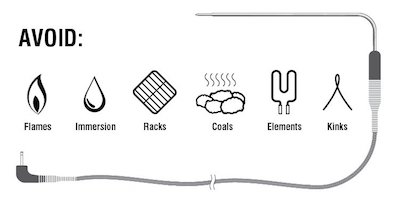
Avoid grilling or broiling with your probes unless you protect your probes, as flare-ups often involve temperatures above your probe’s specifications. We recommend that you use an instant-read thermometer—such as a Thermapen ONE.
- Learn how to prolong the life of your Pro-Series Probe.
- Learn how to protect your probes while grilling.
- Learn how to use your probes with a BBQ smoker.
Important to Know
While our probes are designed to be best of class (each batch is tested to make sure they meet our high-quality standards) and are much hardier than those of our competitors, all cooking probes—no matter what type they are, how expensive they are, or who makes them—are subject to decay over time due to the harsh conditions they are used in. Professional BBQ teams always keep extra probes on hand for this reason. Plus, it never hurts to have more types of probes on hand to handle different kinds of cooks!
As a note: Pro-Series probes come with a 6-month warranty. Please let our Tech Support team know if you need help with yours.
My Signals is displaying an LLL (or HHH) error. What does this mean?
There are several reasons your Signals may display either an LLL or HHH error, the most common being that the probe wire was damaged or broken. If your Pro-Series probe was exposed to temperatures above or below its temperature range (-58 to 572°F or -50 to 300°C), you will see one of these errors.
As a note: Pro-Series probes come with a 6-month warranty. Please let our Tech Support team know if you need help with yours.
My Signals is not reading food temperatures accurately. What’s wrong?
Judging the accuracy of your Signals in food or air can be difficult. The best way to verify the accuracy of a probe or digital thermometer is with a proper ice bath test. This can be done quickly and easily at home with the instructions found here.
If your Pro-Series probe is accurate, it will read within ± 1.8°F of 32°F (30.2 to 33.8°F). If it is reading accurately in this test, you can rest assured that it is reading accurately in food and at higher temperatures.
Please contact our Tech Support team if you need further assistance. They are always happy to help.
Why did my Signals melt?
It is likely that your Signals thermometer (the hardware) was exposed to temperatures above its operating range, which is 32 to 122°F (0 to 50°C). The Signals hardware does not go in the oven when you use it, as high heat will melt it. It should not be attached directly to a smoker or grill.
Instead, insert the Pro-Series probe’s tip into the food you are tracking, connect the other end of the probe to Signals thermometer, and place Signals outside of the oven/smoker (usually on a countertop). Place the food in the oven/smoker and close the door on the cable. Closing the oven door on the probe’s cable won’t hurt it. Because the cable is thin, your oven, grill, or smoker won’t lose any heat

I just received my new Signals. I can’t change the temperatures. What do I do?
Could you check to see if you have removed the screen’s protective film? If you have and your Signals is still not working correctly, please contact our Tech Support team.
How should I care for my Signals?
- The best way to extend the life of your Signals hardware is to clean it properly after each use. Wipe it off with a damp, soapy cloth or paper towel. Do not submerge it or put it in the dishwasher.
- Your Signals should not be affixed directly to a smoker or grill’s lid or left in the smoker or oven. The high heat will melt the plastic housing.
- Avoid having the thermometer’s LCD screen in direct sunlight for an extended amount of time as this can damage the display.
How should I care for Signals’ probes?
- To clean the probe, carefully wipe down the stainless steel cable with a slightly damp, soapy cloth or paper towel. Do not put the probe in the dishwasher or place the entire probe in a sink of water. Submerging the cable can cause damage.
- Your Pro Series probe’s operating range is -58 to 572°F. Keep the probe and cable away from oven heating elements, flames, coals, grills, or racks—all of which can reach temperatures far higher than 700°F (even if an oven or smoker is set lower).
- The probe should not be attached directly to a rack. The high heat of the rack will cause damage to the probe, transition, and cable. Use a grate clip.
- Do not pull on the probe’s cable. Use the molded transition.
- While the cable may be closed in an oven door or under a BBQ hood, avoid pinching the probe’s cable between very hot surfaces, such as a cast metal grill hood, without some insulating protection. Use an access hole if available.
- Store your Pro-Series® probe with the cable free of kinks and lightly coiled, wrapped, or hung loosely.
What is the warranty of the probes that comes with my Signals? I think that one of mine isn’t working correctly.
Pro-Series probes come with a 6-month warranty. Please let our Tech Support team know if you need help with yours.
Signals Warranty Terms
Your Signals hardware has a 2-year warranty. You can read more about the warranty terms here.
Have more questions?
If you have any additional questions or concerns, please contact our Tech Support team by calling 1-385-330-0591 or by emailing techsupport@thermoworks.com.






















